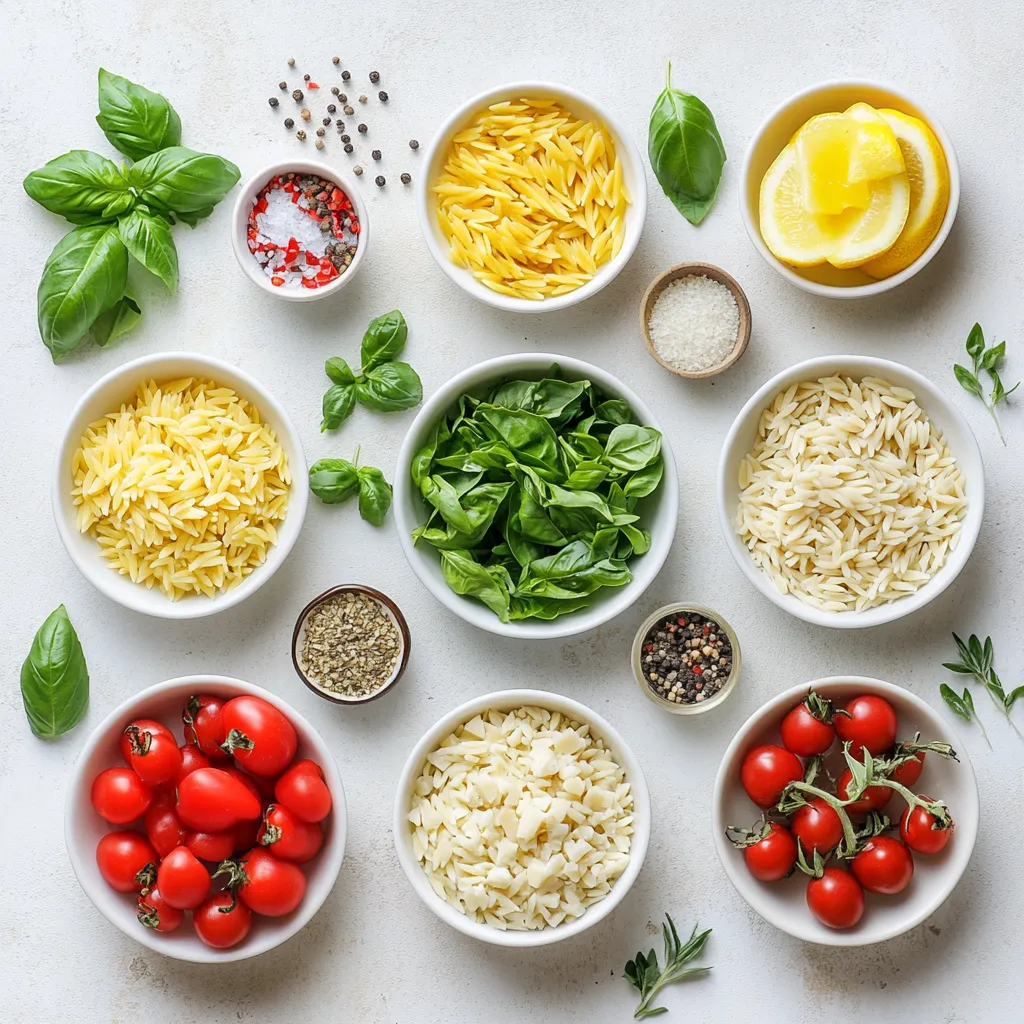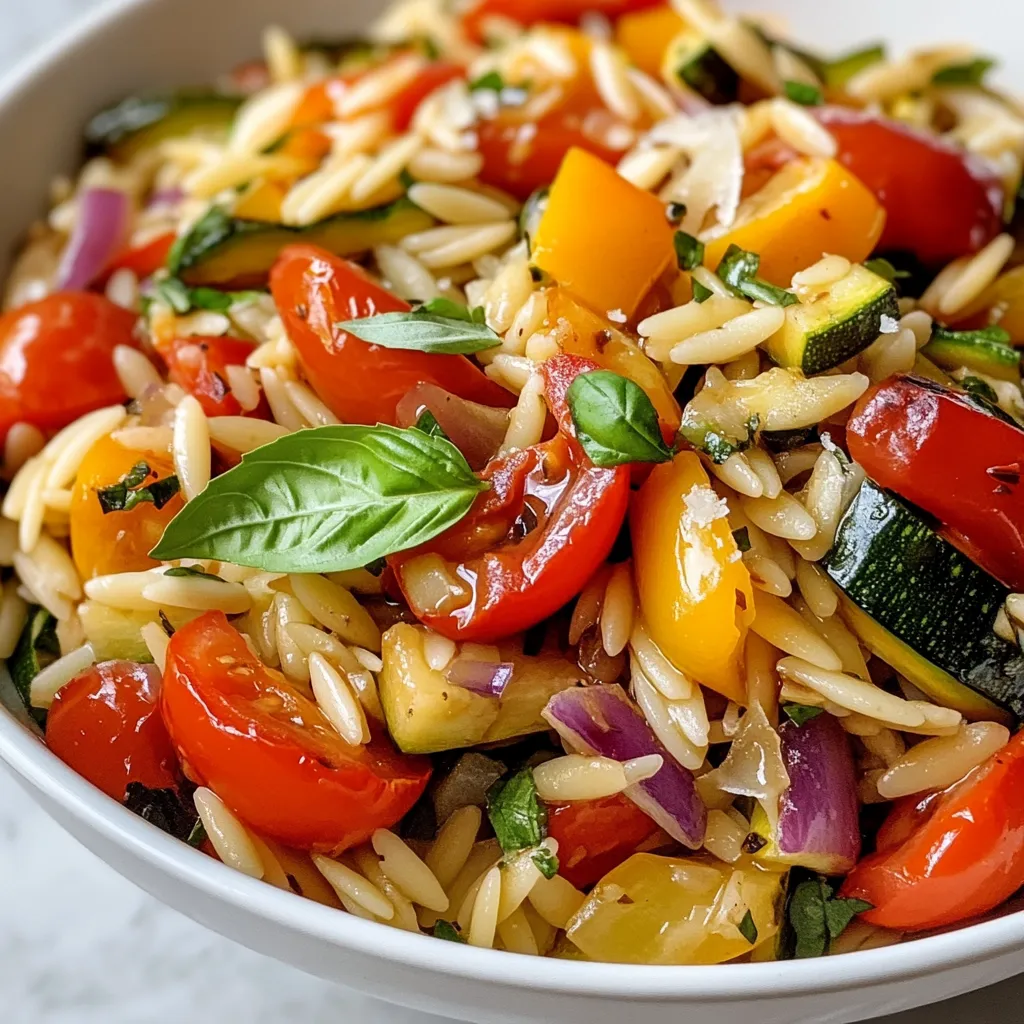Introduction
Roasted Vegetable Orzo Delight is not only a delicious meal but also a celebration of vibrant flavors and textures. This dish beautifully integrates orzo pasta with seasonal vegetables, creating a feast for both the eyes and the palate. The roasting process enhances the natural sweetness of the vegetables while adding depth and richness to the overall flavor, resulting in a delightful combination that is comforting yet light at the same time. Ideal for lunch or dinner, this dish works wonderfully as a main course or a side dish, making it versatile for any dining occasion.
Incorporating an array of seasonal vegetables—like bell peppers, zucchini, cherry tomatoes, and red onions—makes this recipe a true showcase of what nature has to offer. The seasoned vegetables not only contribute to the dish’s nutritional value but also add a colorful array that makes each serving visually appealing. This dish becomes even more inviting with aromatic herbs and a hint of citrus, providing a refreshing finish that enhances all the flavors.
For busy families or individuals looking to enjoy a healthy yet satisfying meal, Roasted Vegetable Orzo Delight is an excellent option. It’s simple to prepare, and the use of seasonal vegetables ensures that you can make it fresh and flavorful throughout the year.
Recipe Overview
– Total Time: 40 minutes
– Servings: 4
– Difficulty: Not specified in the recipe.
Ingredients
– 1 cup orzo pasta
– 2 cups assorted seasonal vegetables (such as bell peppers, zucchini, cherry tomatoes, and red onion)
– 3 tablespoons extra-virgin olive oil
– 1 teaspoon garlic powder
– 1 teaspoon dried oregano
– Salt and freshly ground black pepper, to taste
– 1/4 cup grated Parmesan cheese (optional)
– Fresh basil leaves for garnish
– 1 tablespoon fresh lemon juice

Instructions
1. Preheat the Oven: Begin by preheating your oven to 425°F (220°C) to prepare for roasting the vegetables.
2. Prepare the Vegetables: Wash and chop the assorted seasonal vegetables into bite-sized pieces. Place them in a large mixing bowl. Drizzle with 2 tablespoons of extra-virgin olive oil and sprinkle with garlic powder, dried oregano, salt, and freshly ground black pepper. Toss the vegetables thoroughly until they are evenly coated in the oil and seasonings.
3. Roast the Vegetables: Spread the seasoned vegetables out on a baking sheet in a single layer to ensure even roasting. Place the baking sheet in the preheated oven and roast for about 20-25 minutes, or until the vegetables are tender and have developed a golden-brown caramelization. Be sure to stir them halfway through for consistent cooking.
4. Cook the Orzo: While the vegetables are roasting, bring a medium saucepan of salted water to a boil. Add the orzo pasta and cook according to the package instructions, which typically takes about 8-10 minutes until it reaches an al dente texture. Once cooked, drain the orzo and set it aside.
5. Combine Ingredients: In a large mixing bowl, combine the drained orzo with the roasted vegetables. Drizzle in the remaining tablespoon of extra-virgin olive oil and the fresh lemon juice. If you’re using Parmesan cheese, add it now. Gently toss all the ingredients together until they are well mixed and evenly distributed.
6. Serve: Transfer the orzo and vegetable mixture to individual serving plates or a large serving bowl. For a touch of freshness, garnish with fresh basil leaves and, if desired, add an extra sprinkle of Parmesan cheese. Enjoy this vibrant and nutritious dish!
The Appeal of Roasted Vegetable Dishes
Roasted vegetables are undoubtedly a favorite among food enthusiasts for a multitude of reasons. Firstly, the roasting process brings out a rich, caramelized flavor that is hard to achieve through other cooking methods. Unlike boiling or steaming, which can leach out flavors and nutrients, roasting intensifies the taste, making vegetables more appealing even to those who are typically reluctant to eat them. This method also provides a delightful texture, with crisp exteriors and tender insides, reinforcing the vegetable’s natural structure.
From a nutritional perspective, roasting can enhance the health benefits of vegetables. Many vitamins and minerals become more bioavailable when cooked, and the addition of oils and herbs during the roasting process can increase the absorption of fat-soluble vitamins. This makes dishes like Roasted Vegetable Orzo Delight not only flavorful but also nourishing.
Moreover, the versatility of seasonal vegetables allows for creativity in the kitchen. Chefs and home cooks alike can tailor their selections based on current availability, ensuring freshness and supporting local agriculture. This versatility promotes a deeper understanding and appreciation for seasonal eating, encouraging individuals to connect with the natural rhythms of food production.
Embracing Seasonal Ingredients
Using seasonal ingredients in recipes is a time-honored tradition that helps celebrate the best of what each season has to offer. Seasonal vegetables are typically at their peak in terms of flavor, texture, and nutritional content, which is particularly important when creating dishes such as Roasted Vegetable Orzo Delight. Not only do these ingredients taste better, but they are often more affordable and environmentally friendly, as they don’t require long transportation times.
When selecting seasonal vegetables, consider visiting local farmers’ markets or farm stands, where you can find fresh produce straight from the source. This not only boosts the local economy but also allows consumers to experience a broader range of flavors and varieties. Seasonal eating encourages diversity in one’s diet, as it naturally leads to incorporating a greater number of vegetables throughout the year, promoting overall health.
In the case of our orzo dish, vegetables like bell peppers, zucchini, and cherry tomatoes are not only delicious but also visually striking. Their bright colors can entice appetites and create an aesthetically pleasing plate, an important aspect of any meal. Embracing seasonal ingredients ultimately fosters a deeper appreciation for food and the environment it comes from.
Why Orzo is the Ideal Base
Orzo pasta is an ideal base for many dishes, including Roasted Vegetable Orzo Delight, for several reasons. Firstly, its unique shape—similar to that of a grain of rice—allows it to absorb flavors exceptionally well. This means that when tossed with roasted vegetables and seasonings, the orzo not only provides a great textural contrast but also enhances the overall dish by soaking up the fragrant oils and juices from the vegetables.
Additionally, orzo’s neutral flavor makes it a versatile canvas. It can seamlessly blend with various ingredients, from meats to our delicious assortment of seasonal vegetables. This makes it an excellent choice for both vegetarian and non-vegetarian dishes. It can also be dressed up or down, accommodating a variety of dietary preferences, whether served solo or complemented by proteins.
The cooking time for orzo is relatively short, allowing for a quick assembly in contrast to other pasta varieties. It pairs wonderfully with the roasted vegetables, creating a satisfying meal that is hearty yet light enough for any occasion. When combined with the fresh lemon juice and optional Parmesan cheese, orzo becomes a standout feature in a dish filled with robust flavors.

Choosing the Right Pot for Cooking
When it comes to cooking the orzo pasta, selecting the right type of pot is essential for optimal results. A large, deep saucepan is ideal as it allows the pasta ample space to cook evenly without clumping together. This helps maintain the pasta’s shape and texture, leading to a more pleasant eating experience. Non-stick or stainless-steel pots are great choices, as they prevent sticking and ensure even heat distribution.
Salting Water: Why It Matters
Salting the cooking water is a critical step in the pasta cooking process that enhances flavor. A well-salted pot of water will season the pasta internally as it cooks, which is crucial for building a flavor base for your orzo dish. It’s recommended to use about 1-2 tablespoons of salt per gallon of water. This method infuses the orzo with flavor, making each bite richer and more enjoyable.
Cooking Times and Achieving Al Dente
Cooking orzo to an al dente texture—meaning “to the tooth”—is important for achieving the desired bite that complements the roasted vegetables. Usually, this takes about 8-10 minutes. Keep an eye on the clock and regularly taste the pasta starting at the 8-minute mark. When cooked al dente, orzo should be firm to the bite but not hard. Overcooking can cause the pasta to become soft and mushy, detracting from the overall dish.
Combining Ingredients
Best Practices for Mixing
When combining the roasted vegetables with the orzo, it’s best to use a large mixing bowl. This offers enough space to toss the ingredients without spilling. Begin by ensuring the vegetables have cooled slightly; adding hot vegetables to pasta can cause it to clump. Gently fold the ingredients rather than stirring vigorously to avoid breaking the orzo and maintain a light texture.
The Role of Lemon Juice in Brightening Flavors
Lemon juice not only adds a refreshing tang but also balances the richness from the olive oil and the optional Parmesan cheese. Its acidity enhances the overall flavor profile, making the dish taste fresher and more vibrant. When drizzling lemon juice, adjust it to your preference; starting with about a tablespoon will allow you to gauge how much brightness you desire without overpowering the other flavors.
Optional Add-ins: When and How to Use Cheese
If you choose to add Parmesan cheese, it’s best incorporated just after mixing the orzo and vegetables. This allows the cheese to melt slightly and adhere to the pasta and veggies, creating a creamy texture throughout the dish. If you’re looking for alternatives for reducing dairy intake, consider using nutritional yeast for a similar cheesy flavor without the lactose.
Presentation Techniques
Family-Style vs. Individual Plating
Presenting Roasted Vegetable Orzo Delight can be tailored to the occasion. For family-style dining, a large bowl brimming with the orzo and vegetables encourages a communal vibe. On the other hand, for a more refined setting, plated servings can showcase each component. Individual plating allows for aesthetic garnishes and personalized servings, enhancing the dining experience.
Garnishing with Fresh Basil
Fresh basil leaves not only add a pop of color but also infuse the dish with a lovely aromatic herb profile. They can be scattered on top or placed strategically on each plate. To enhance visual appeal, consider slicing basil leaves into thin ribbons (chiffonade) before garnishing to create a stunning presentation that whets the appetite even before the first bite.
The Effect of Balsamic Glaze on Presentation
Drizzling balsamic glaze over the top of the dish prior to serving adds both flavor complexity and an elegant finish. Its sweetness pairs marvelously with roasted vegetables, resulting in a contrast that highlights the natural sweetness of the dish. To achieve a refined presentation, use a squeeze bottle for finer control over the design when drizzling.
Flavor Profile
Balancing Savory and Fresh Ingredients
The beauty of Roasted Vegetable Orzo Delight comes from its harmonious blend of savory and fresh ingredients. The roasted vegetables bring depth and sweetness, while the lemon juice and basil provide refreshing notes. Balancing these components can elevate the dish further; consider adjusting the ratios of vegetables or lemon according to your flavor preference.
Deepening Complexity with Garlic and Oregano
Garlic powder and dried oregano impart a robust flavor foundation. These ingredients should be balanced carefully to avoid overwhelming the dish. Their aromatic qualities enhance the essence of the vegetables and pasta, creating a well-rounded taste experience. Adding more of either can introduce more layers of flavor, but sprinkle a little at a time and taste as you go.
Tips for Adjusting Seasoning to Taste
Every palate is different, so tasting as you go is essential. Once you combine all ingredients, give it a gentle toss and take a bite. If it needs more zest, a tad more lemon juice can provide that brightness. If it seems bland, a pinch more salt or pepper can enhance overall flavor. Remember, herbs and spices can be adjusted to personal preference to ensure the dish meets your taste expectations.
Storing Leftovers
Proper Storage Techniques
To store any leftover Roasted Vegetable Orzo Delight, allow it to cool to room temperature before transferring it to an airtight container. This enables proper airflow, preventing condensation that can lead to sogginess. It’s best to consume leftovers within 3-4 days for optimal flavor and freshness.
Reheating Best Practices
When reheating, it’s best to do so gently to avoid overcooking the orzo a second time, which can result in a mushy texture. Use a microwave or a stovetop. If using a microwave, cover the dish to retain moisture, heating in short intervals and stirring in between. If using a stovetop, add a splash of water or broth to prevent sticking, gently warming it over low heat while continuously stirring.
How to Maintain Texture and Flavor Over Time
To maintain the dish’s texture and flavor during storage, avoid mixing in any fresh ingredients (like the basil or cheese) until right before serving. This helps keep garnishes fresh and prevents sogginess in the main dish. Separating ingredients will also prevent the orzo from absorbing too much moisture and losing its al dente characteristic.
Serving Suggestions
Ideal Pairings for Roasted Vegetable Orzo
Roasted Vegetable Orzo Delight is versatile and pairs well with various side items. A simple green salad with a tangy vinaigrette balances the dish’s richness, or serve with crusty bread to soak up any lingering flavors from the plate. For protein additions, grilled chicken or shrimp can complement the dish beautifully, rounding out a wholesome meal.
Accompaniments to Elevate the Meal
Consider incorporating dips like hummus or tzatziki to enhance a Mediterranean theme, matching the garlic and herb profile. A charcuterie board with artisanal cheeses and cured meats can also elevate the dining experience, making it ideal for gatherings or casual entertaining.
Themed Dinner Ideas Featuring This Dish
For a Mediterranean-themed dinner party, pair Roasted Vegetable Orzo Delight with stuffed grape leaves and spanakopita as appetizers. For dessert, a light fruit sorbet can provide a refreshing close to the meal. This dish fits effortlessly into a vegetarian spread yet can also complement grilled meats for a mixed dining scenario.
Conclusion
Roasted Vegetable Orzo Delight offers a vibrant combination of textures and tastes, with the creaminess of optional cheese and the fresh notes from lemon and basil elevating the dish. The entire preparation can be completed in about 40 minutes, making it an appealing choice for both casual dinners and more formal gatherings. With its wholesome ingredients and flexibility for adjustments, it stands as a delightful addition to any meal repertoire.

Roasted Vegetable Orzo Delight
Ingredients
- 1 cup orzo pasta
- 2 cups assorted seasonal vegetables
- 3 tablespoons extra-virgin olive oil
- 1 teaspoon garlic powder
- 1 teaspoon dried oregano
- to taste salt
- to taste freshly ground black pepper
- ¼ cup grated Parmesan cheese
- 1 tablespoon fresh lemon juice
- for garnish fresh basil leaves
Instructions
- Preheat your oven to 425°F (220°C).
- Wash and chop the assorted seasonal vegetables into bite-sized pieces.
- In a large bowl, toss the vegetables with 2 tablespoons of olive oil, garlic powder, oregano, salt, and pepper.
- Spread the vegetables on a baking sheet and roast for 20-25 minutes, stirring halfway through.
- In a saucepan, bring salted water to a boil and cook the orzo according to package instructions for 8-10 minutes.
- Drain the orzo and set aside.
- In a large bowl, combine the drained orzo with the roasted vegetables.
- Drizzle with the remaining olive oil and lemon juice, and add Parmesan if using.
- Gently toss to mix all ingredients well.
- Serve garnished with fresh basil leaves and additional Parmesan if desired.

